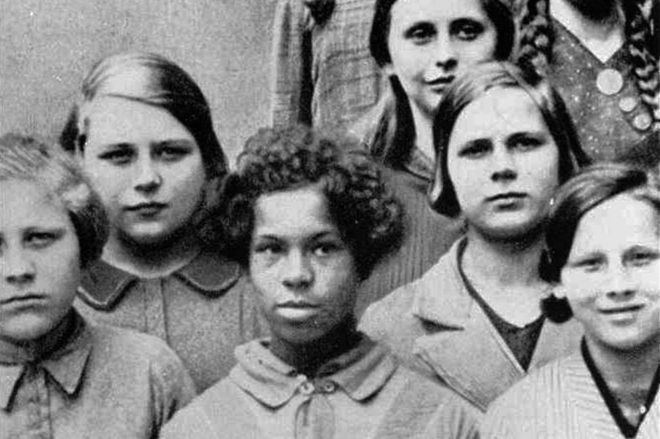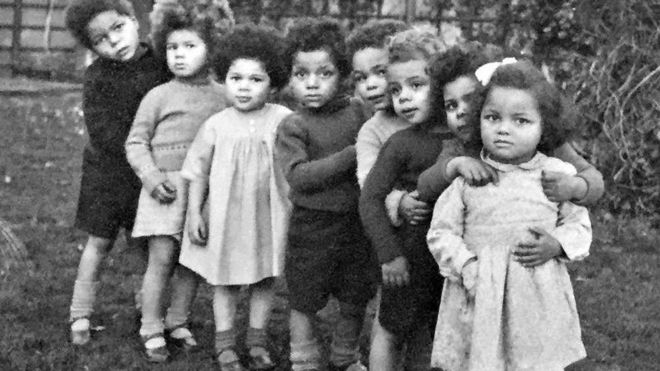Interracial Relationships and the “Brown Baby Question”: Black GIs, White British Women, and Their Mixed-Race Offspring in World War IIInterracial Relationships and the “Brown Baby Question”: Black GIs, White British Women, and Their Mixed-Race Offspring in World War II
Journal of the History of Sexuality
Volume 26, Number 3, September 2017
pages 424-453
Lucy Bland, Professor of Social and Cultural History
Anglia Ruskin University, Cambridge
Sergeant Lomax, an African American soldier, arrived back in Ohio at the end of the Second World War; he had been stationed in England for much of his time away. He had a confession to make to his wife, Betty. In February 1949 she recounted their exchange to the Pittsburgh Courier, a leading black American newspaper: “He said: ‘I’ve been gone a long time . . . about three years . . . that’s a long time for a fellow to be away from his wife. In the meantime I met a girl. She was nice, she was friendly, and Betty, I was very lonesome, so . . . what I’m trying to say is that there’s to be a child. Betty, you don’t have to answer right away, but would you agree to take this child?’”1 The boy had been born in December 1945 and was given the same name as his father: Leon Lomax. He was put into a children’s home in Britain by his single mother. With great difficulty, Leon senior eventually managed to have his son flown out to the United States, arriving in January 1949. The Pittsburgh Courier called his arrival “the story of the year! . . . The first ‘Brown Baby’ adopted by an American couple to reach America.”2 “Brown babies” was the name that the African American press of the time gave to mixed-race children born to black American soldiers and British and European women (the vast majority of whom were white) during or soon after the Second World War.3 One African American paper, the Chicago Defender, sometimes also referred to them as “tan-yank babies.”4 To the Pittsburgh Courier “the entire ‘Brown Baby’ question is one of the most controversial subjects in this country today. It is a question that involves two great nations—the United States of America and Great Britain.”5 The nature of this “controversial subject”—the “‘Brown Baby’ question”—is the focus of this article.
The British “brown babies” were the result of relationships formed between British women and African American troops stationed in Britain from 1942 in preparation for an invasion of France. From the beginning there was concern in official circles about the consequences of the presence of black GIs. Home Secretary Herbert Morrison, for example, was anxious that “the procreation of half-caste children” would create “a difficult social problem.”6 He and others in the War Cabinet would have preferred that no black GIs be sent at all. However, black troops did indeed arrive, following the Pentagon’s policy that the percentage of black American troops in every theater of war should reflect their percentage in the United States as a whole, namely, 10 percent of the population.7 By the end of the war, of the nearly three million US soldiers who had passed through Britain, up to three hundred thousand were African American.8
Unlike the British government, British civilians largely reacted positively to the presence of black GIs. A report from the Home Intelligence Unit (an organization set up in 1940 to monitor morale) noted the numerous references to “the extremely pleasing manners of the coloured troops.”9 Many may have agreed with the response of a West Country farmer when asked about the GIs: “I love the Americans, but I don’t like these white ones they’ve brought with them.”10 Historian Graham Smith suggests that one of the reasons the black GIs were seen as better mannered was that while the white GIs constantly complained about Britain’s lack of modern conveniences—no refrigerators, no central heating, few cars—most of the black GIs were not used to such luxuries at home and thus did not have reason to find fault.11 However, British attitudes were frequently condescending and informed by negative stereotypes. For example, the June 1943 Home Intelligence report “British Public Feeling about America,” which drew together some of the remarks people had made over the past year and a half, noted (without…
Read or purchase the article here.





:focal(942x790:943x791)/https://public-media.si-cdn.com/filer/6b/51/6b510bda-3f1d-438e-806c-af38a51897aa/gettyimages-613497858.jpg)

